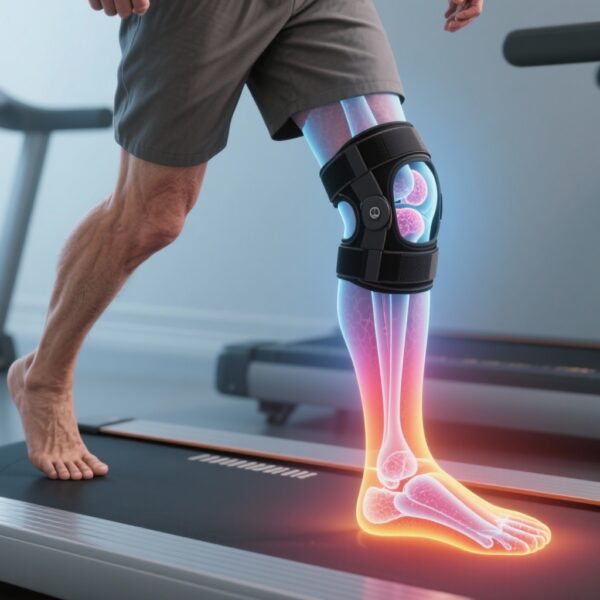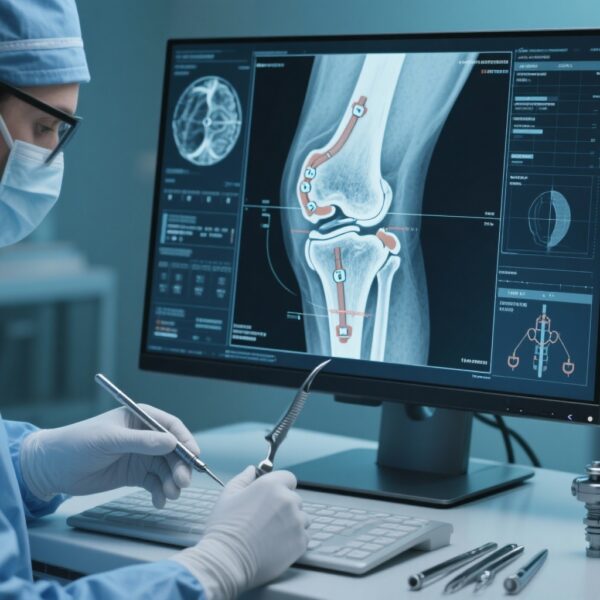Highlights
– A 2025 systematic review and meta-analysis of 23 randomized trials (n≈1,265 for PA outcomes) shows physical activity (PA) interventions after total knee or hip arthroplasty modestly increase overall PA (SMD 0.16, 95% CI 0.01–0.30; high certainty).
– Effects were seen for step counts (SMD 0.22, 95% CI 0.05–0.40) but not for moderate-to-vigorous physical activity (MVPA; SMD −0.01, 95% CI −0.33 to 0.30).
– Interventions that incorporated wearable activity trackers (SMD 0.38), behaviour-change techniques (SMD 0.20), and that were started within two weeks after surgery (SMD 0.32) produced the largest effects.
– Evidence on reducing sedentary behaviour is sparse and very low certainty (SMD −0.19, 95% CI −0.66 to 0.29).
Background
Total hip arthroplasty (THA) and total knee arthroplasty (TKA) are high-volume elective procedures aimed at relieving pain and restoring function in advanced hip or knee osteoarthritis. Although surgery reliably reduces pain and improves joint-specific function, improvements in objectively measured physical activity and reductions in sedentary behaviour are not guaranteed. Given the cardiometabolic risks associated with inactivity and prolonged sitting, and the contribution of PA to overall recovery and long-term health, interventions that meaningfully change patient activity patterns after arthroplasty are of clinical interest.
Study design and methods
The referenced paper by d’Unienville et al. (Osteoarthritis Cartilage. 2025) performed a systematic review and meta-analysis of randomized controlled trials (RCTs) evaluating pre- and post-surgery interventions that aimed to increase general physical activity or reduce sedentary behaviour in adults undergoing TKA or THA. Trials were included if they reported PA or sedentary behaviour outcomes; effects were pooled using standardized mean differences (SMDs). The investigators carried out subgroup analyses by intervention features (e.g., wearable trackers, behaviour-change techniques), timing relative to surgery (pre-op vs early post-op), outcome type (steps, MVPA), and follow-up duration. Risk of bias and certainty of evidence were assessed using the PEDro scale and GRADE methodology respectively.
Key findings
Population and trials: Twenty-three RCTs met inclusion criteria. Meta-analysis included approximately 1,265 participants for PA outcomes and 270 participants for sedentary behaviour outcomes. Interventions were heterogeneous and ranged from structured physiotherapy plus behaviour counselling to technology-supported programmes using pedometers or wrist-worn activity trackers.
Primary pooled effects
– Overall effect on physical activity: Interventions produced a small but statistically significant improvement in PA (SMD 0.16; 95% CI 0.01–0.30). The GRADE assessment rated this as high-certainty evidence.
– Effect on sedentary behaviour: Pooled data showed no clear reduction in sedentary time (SMD −0.19; 95% CI −0.66–0.29), a finding with very low certainty due to limited data and heterogeneity.
Specific outcome subgroups
– Step count: Interventions increased step-counts (SMD 0.22; 95% CI 0.05–0.40). While SMDs are standardized, this magnitude likely corresponds to modest absolute improvements (order of hundreds rather than thousands of additional steps per day), depending on baseline variability.
– Moderate-to-vigorous physical activity (MVPA): There was no meaningful effect on MVPA (SMD −0.01; 95% CI −0.33–0.30), suggesting interventions boosted light-intensity ambulatory activity (steps) more than higher-intensity exercise.
Influence of intervention characteristics (subgroup findings)
– Wearable activity trackers: Trials that integrated wearable devices (e.g., wrist-based trackers) had larger effects (SMD 0.38; 95% CI 0.18–0.57). This aligns with broader literature that pedometer- and wearable-based feedback can increase ambulatory behaviour.
– Behaviour change techniques (BCTs): Interventions explicitly incorporating behaviour-change methods (goal setting, self-monitoring, feedback) produced greater improvements (SMD 0.20; 95% CI 0.01–0.39). This is consistent with behaviour-science principles and formal BCT taxonomies.
– Timing: Interventions initiated within two weeks after surgery had larger effects (SMD 0.32; 95% CI 0.14–0.50) compared with later starts, suggesting an early postoperative window may be opportune for shifting habitual activity.
Follow-up and durability
Most trials provided short- to medium-term follow-up (weeks to months). Evidence on long-term maintenance (>12 months) was sparse. As a result, the durability of post-intervention gains in PA is uncertain.
Safety and adverse events
Included trials did not report major safety signals attributable to PA promotion. Typical postoperative adverse events were monitored in surgical care pathways, and no consistent increase in complications was linked to activity-promotion interventions in the trials reviewed.
Clinical interpretation and relevance
The meta-analysis demonstrates that interventions delivered around the time of joint replacement can produce small but reliable increases in overall PA and step counts. These effects are largest when interventions combine objective feedback from wearables with evidence-based behaviour-change strategies and are started early after surgery.
However, the effect sizes are modest. A standardized mean difference of 0.16–0.22 represents a small average change; the absolute benefit for an individual depends on baseline activity variability. Importantly, interventions primarily increased ambulatory and light-intensity activity rather than MVPA, suggesting programmes that aim to elevate aerobic or higher-intensity exercise may need different or additional elements (progressive exercise prescriptions, supervised training). The lack of clear reductions in sedentary time indicates that reducing sitting is not a guaranteed consequence of increasing steps, and may require targeted strategies (scheduled standing breaks, environmental modifications, behavioural prompts).
Expert commentary and limitations
Strengths of the evidence include the randomized design of included trials and objective measurement of many outcomes (accelerometry, step counters). The finding that wearables plus BCTs are effective is consistent with broader behavioural medicine literature (e.g., pedometer interventions in general populations) and with behaviour-change theory.
Key limitations that temper conclusions:
- Heterogeneity: Trials varied in patient populations (TKA vs THA), baseline activity levels, intervention intensity, components, and outcome measurement (device types, epochs, thresholds), which complicates pooling and clinical translation.
- Small effects: While statistically significant for PA, effect sizes were small and may be of limited clinical significance for individual patients without sustained maintenance.
- Short follow-up: Few trials reported 12-month or longer outcomes, so long-term behaviour change and its impact on cardiometabolic health remain uncertain.
- Risk of bias and reporting: Variation in methodological quality (assessed by PEDro) and incomplete reporting of intervention content in some trials limit replication and implementation.
- Sedentary behaviour evidence: Data are sparse and heterogeneous; trials generally targeted PA rather than directly aiming to reduce sitting time, which may explain the null sedentary findings.
Implementation implications for clinicians
– Consider integrating simple, evidence-based PA promotion into perioperative care pathways for TKA and THA patients. Components with best supporting evidence are objective activity feedback (wearables/pedometers), goal-setting, self-monitoring, and regular feedback from clinicians or coaches.
– Start early: Initiating PA-promoting strategies within two weeks postoperatively appears advantageous, but patient safety, wound healing, and mobility must be ensured.
– Tailor intensity: Expect modifications in light activity and steps; for meaningful increases in MVPA, combine behavioural approaches with structured exercise progression and supervised training when indicated.
– Address sedentary behaviour directly: Reducing sitting requires explicit targets and strategies (timed prompts to stand/move, workplace/home modifications), not only promotion of step-counts.
Research priorities
– Large, well-reported RCTs with longer follow-up that evaluate clinically meaningful outcomes (cardiometabolic markers, function, quality of life, rehospitalization) and cost-effectiveness are needed.
– Trials that explicitly test reduction of sedentary time as a primary outcome, with interventions designed for standing/interrupting sitting, are necessary.
– Comparative effectiveness studies to isolate active ingredients (e.g., tracker alone vs tracker + BCT vs supervised exercise) would inform efficient program design.
Conclusion
Perioperative PA interventions for patients undergoing hip or knee arthroplasty produce small but reliable increases in overall physical activity and step counts, especially when interventions combine wearable activity trackers with behaviour-change techniques and are started early after surgery. Evidence that these programmes reduce sedentary behaviour is insufficient. Clinicians and health services should consider incorporating wearable-enabled, behaviourally informed PA promotion into arthroplasty pathways, while prioritizing trials with longer-term follow-up and explicit targets for reducing sedentary time.
Funding and clinical trials
The systematic review cited (d’Unienville et al., 2025) should be consulted for details on funding sources and trial registrations of included RCTs. Individual trials varied in funder and registration reporting; readers seeking trial-level registration numbers or funding disclosures should review the primary publications included in the meta-analysis.
Selected references
1. d’Unienville N, Singh B, Gower B, Szeto K, Badger H, Krywanio M, Maher C, Thewlis D. Effects of pre- and post-surgery physical activity interventions on physical activity and sedentary behaviour levels following knee and hip arthroplasty: A systematic review and meta-analysis of randomised controlled trials. Osteoarthritis Cartilage. 2025 Sep;33(9):1066-1081. doi:10.1016/j.joca.2025.07.003.
2. World Health Organization. WHO guidelines on physical activity and sedentary behaviour. 2020. Available at: https://www.who.int/publications/i/item/9789240015128 (accessed 2025).
3. Artz N, Elvers KT, Lowe CM, Sackley C, Jepson P, Beswick AD. Effectiveness of physiotherapy exercise following total knee replacement: systematic review and meta-analysis. BMC Musculoskelet Disord. 2015;16:15.
4. Bravata DM, Smith-Spangler C, Sundaram V, et al. Using pedometers to increase physical activity and improve health: a systematic review. JAMA. 2007;298(19):2296–2304.
5. Michie S, Richardson M, Johnston M, et al. The behaviour change technique taxonomy (v1) of 93 hierarchically clustered techniques: building an international consensus for the reporting of behaviour change interventions. Ann Behav Med. 2013;46(1):81–95.
Thumbnail image prompt
A clear, bright hospital corridor with a middle-aged adult in walking clothes and a wrist-worn activity tracker, walking alongside a physiotherapist who points ahead; natural light, gentle motion blur to emphasize movement, inclusive and professional clinical setting.



